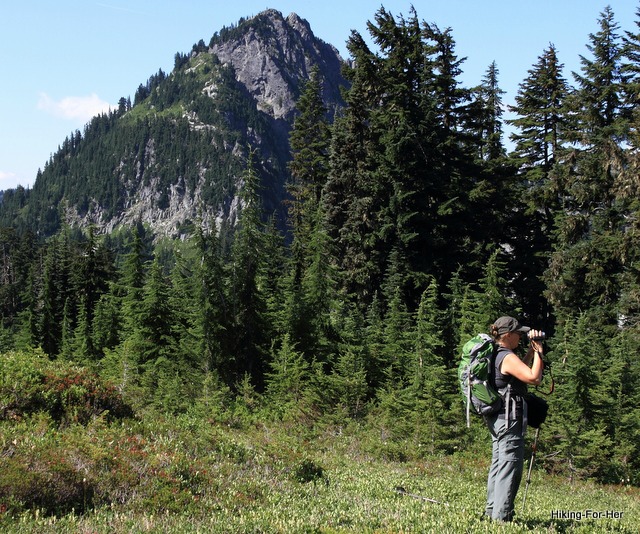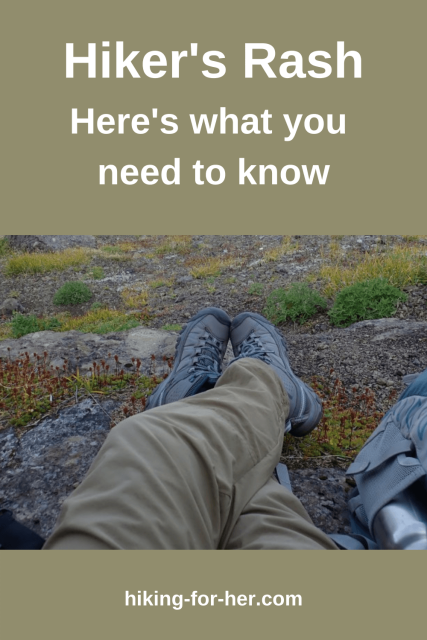
Hikers Rash: What Is It?
What Can You Do About It?
By Diane Spicer
Hikers rash (also spelled as hiker's rash) pops up mysteriously on one or both legs, and makes you wonder what's going on with your skin.
NOTE: This article is not medical advice. Always consult a medical care professional with your health concerns.
To get an overview of the medical details of hikers rash, read this research abstract by Dr. Olivier Espitia and colleagues: Exercise-Induced Vasculitis: A Review with Illustrated Cases
Here, let's roll through how to recognize it, and what to do if hikers rash interrupts your hiking plans.
Other names for hikers rash
Brace yourself for a long name, along with some activity-associated names.
Hikers rash in medical circles is called exercise induced vasculitis (EIV).
- Any " -itis" means inflammation, and "vasc" tells you what's inflamed: blood vessels.
To be even more specific, EIV is an isolated cutaneous vasculitis with a specific set of signs and symptoms.
- In other words, you won't get this rash over your whole body, and it stays superficial, skin level.
- It presents pretty much the same on everybody, within a small set of variations (more below).
Whew! That's good news, isn't it!
Now for the more entertaining names:
- golfer's rash
- Disney rash
So what do hikers, golfers, and people who walk for miles and miles in summer heat at Disneyland have in common?
They're putting a lot of pressure on their lower legs.
Let's go over the way this rash looks and why it appears on human legs, including some hikers.

What does hikers rash look like?
Think about your legs on a hike during hot, humid weather as you sweat your way up a trail.
You'd expect dust, grit, grime and trails of sweat, right?
Then imagine them covered with tiny dark dots and patches of irritated skin.
Sometimes welts (raised bumps due to fluid accumulation) appear.
- To see photos of the rash, go here.
Then imagine the itching and discomfort that may be associated with your upset skin.
Or not! Sometimes you don't know you have this condition until you look at your legs as you take off your socks.
That's hiker's rash a.k.a. exercise induced vasculitis (EIV).
Clues to what's going on with hikers rash
Here are two good clues that it might be EIV:
- The rash occurs on ankles and calves, sometimes even up to the thighs.
- It's usually on areas NOT covered by socks or clothing. Above the sock line, in other words.
That's hiker's rash, and yes, it can happen when you're on a golf course or walking around Disneyworld, too.
But why?
Why does hiker's rash happen?
This rash happens because a hiker on the trail on a hot, sunny day is exercising non-stop for hours at a time.
The small blood vessels in the legs become inflamed from the prolonged exercise.
- They're trying to empty and fill, delivering oxygen to hard working muscles, but they can't quite keep up with the load.
Their response? They swell up, turn a dark color that can be seen through the upper layers of the skin, and voila! a rash is born.
No need to worry about this rash being contagious.
It's yours, and yours alone, for up to 10 days.
Trail tip:
If the hiker isn't conditioned for a long day but puts one in anyway, it's more likely for this vasculitis to occur.
So this rash can pop up in the early days of a long backpacking trip.
It may also occur when mileage on any day is increased significantly on a backpacking trip.
To complete our look at why hikers rash hits some hikers more than others, here's a summary of a Case-Control Study on Exercise-Induced Vasculitis in Hikers which compared two groups in a hiking club.
It's worth noting that EIV cases had more chronic venous disease and longer mean walking distances than controls in this study.
Prevention and treatment for hikers rash
Let's tackle this question in two ways: prevention and dealing with it after the fact.
 Will this hiker experience hiker's rash?
Will this hiker experience hiker's rash?
Ways to prevent hiker's rash
When you're headed into hot, sunny terrain and know you'll be hiking for long periods of time, there are several things you can do to prevent this rash on your legs.
1. Keep your legs covered.
- Probably not what you want to do in hot weather, but you could compromise and wear long compression socks (tips on selecting them here.)
- Or choose full coverage clothing in lightweight, UPF fabric, with these tips.
2. Stay hydrated, being extra vigilant about frequent water consumption if you're a female over 50 (a common group to be hit with this rash).
3. Put your feet up on your breaks. This allows fluid to return to the heart, rather than pooling in your lower body.
4. Condition your body ahead of time to accept the load of high mileage carrying a backpack.
Trail tips:
If you've already experienced hiker's rash, you're at elevated risk of a repeat occurrence. Dr. Espitia above estimates it at around 77%. It might be prudent to take precautionary measures every time you hike, such as:
- Wear compression socks (tips on choosing the best pair).
- Use a hydration backpack.
- Take breaks for hydration throughout each day to get off your feet, elevating your legs when possible.
- Include time for rest days (zero days or nero days) into your backpacking itinerary.
Ways to deal with hiker's rash
Lucky you, a blooming rash across your lower body.
Now what?
The first thing to do once you notice it is to cool down the area, easier said than done if you're in a hot, sunny, dry area.
Get out your bandana or a clean shirt, get it wet, get into whatever shade is available, and take a break with elevated legs.
If you have access to cold water or a snow field, so much the better for soaking your skin.
If you're itchy, and you have anti-itch lotion in your first aid kit, that might help keep your mind off the rash. The last thing you want is to scratch open the irritated skin.
Keep direct sunlight off the affected areas.
To enhance healing, consider a modification to your backpacking plans.
- Taking a rest day, hiking before and after the heat of the day, covering your legs, all can be helpful.
Know that hiker's rash will resolve on its own.
It's unpleasant, but it won't give you a fever or other complications. If those occur, get to a doctor and get checked out.
More hot weather hiking tips
There are other skin related problems beyond hikers rash that may pop up during hot weather hiking, like heat rash, allergic reactions and hives.
If in doubt, always consult a medical care professional.
Preparing your body to hike in hot weather is serious business. Don't trudge along sweltering trails without thinking ahead to what to bring and what to do in the heat.
It's more than just drinking water often, although that's a great place to start.
Find out more here:
Add this to your Pinterest hiking boards and never have to search for best hikers rash tips again!
Hikers Rash Facts
|
I get emails all the time about what I wear, eat, carry and love to use on the trail. That's
why I provide affiliate links to you: the best gear that I use myself and have seen used by other hikers is instantly
available for your consideration, and the gear company sends a few
pennies per dollar to this reader-supported hiking website. There is no added cost to you! Everyone ends up a winner: Great gear for you, strong gear companies, and more free hiking tips for everyone. Thanks very much for your support. It's warmly and sincerely appreciated. It also helps send these hiking tips to all your virtual trail buddies around the globe. |
 |


